2024-06-10
When we are hungry, we tend to grumble and show signs of irritation and even anger until we have our basic need for food satisfied.
Our paw friends can not just tell us that they are hungry but similarly to us, they also exhibit specific types of behaviors to make us aware of their need for food.
Owners typically do not have any issues recognizing when their dogs are hungry, as they are able to understand their body language and vocalization.
However, there might be some behaviors that your dog occasionally shows, which surprisingly could mean “I am hungry!”. Let’s dive into dogs’ behavior and find out what our furry friends do to “tell us” that they are hungry.
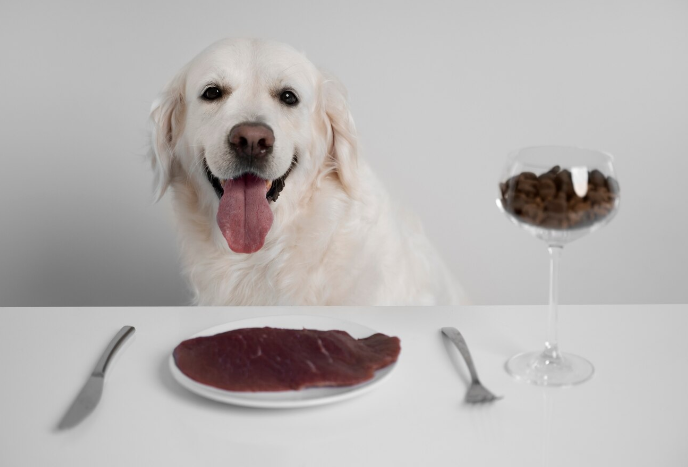
Barking and whining are common types of behavior in dogs, that they show to communicate with us their needs.
Before you decide to ignore your paw friend or even scold them for being loud, take a moment to think of what their vocalization could mean at the exact moment. Did you feed them? Did you take them for a walk? Did you play with them today or otherwise engaged in any activities with them?
As a general rule, dogs should be fed twice a day. However, how often they will get their meals and how big their portions will be, depends on their age, size, activity level, and nutritional needs.
Try making a schedule so that your furry friend knows when meal time is. This will help reduce their anxiety and irritation and make them more patient throughout the day.
If you have already fed your paw friend several times, but they continue whining and barking, you should check what other needs or potential issues this vocalization possibly expresses.
It is important though that you prevent your pet companion from showing unwanted behaviors only to get your attention whenever they want. Training them in basic obedience, setting up a routine, and redirecting their attention to desirable behaviors and activities is advisable in this case.
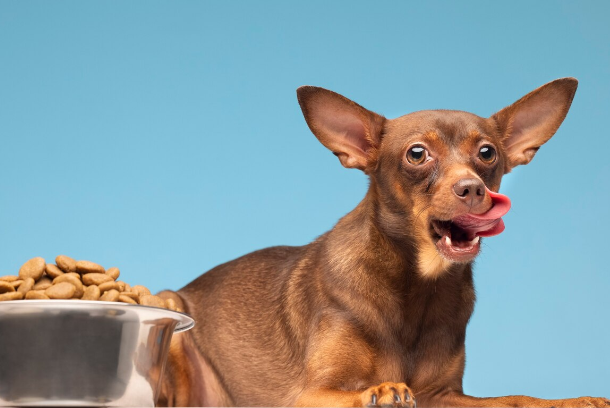
Licking their lips can be interpreted differently based on the situation.
One of its primary meanings is a reflex reaction in dogs (also humans) when they are hungry. The salivary glands produce saliva which is needed for chewing.
Also, if you have made a schedule and your dog knows that they will eat at a certain time of the day, they may start salivating and licking their lips when that time comes, whether food is present or not.
There is an interesting research, conducted by the physiologist Pavlov, that some of you may have heard of. It is studying classical conditioning or simply put-the process of pairing two stimuli together to create a new (learned) response in humans and animals.
For instance, if you start wearing the same clothes every time you feed your dog, they may start salivating when they see those clothes.
It is worth noting, that licking their lips may have nothing to do with food. Another possible explanation of why your paw friend licks their lips is a coping mechanism with stress and anxiety in the presence of stimuli. You should be aware of any triggers in your dog’s environment so that you can either avoid them or desensitize your dog’s reaction towards them.
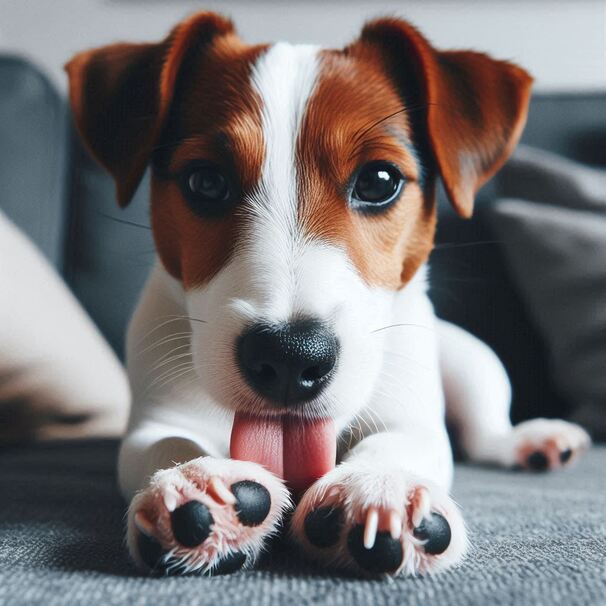
Similar to licking their lips, licking their paws also increases saliva production which is needed for the process of chewing. It typically occurs when your paw friend is hungry. Of course, occasionally licking the paws is pretty normal and is a natural part of grooming, which helps dogs clean their paws.
However, licking the paws or other parts of the body can be also a sign of irritation, injury or an open wound on the paw, so if the licking becomes excessive, you should take a look and consult with a veterinarian if needed.
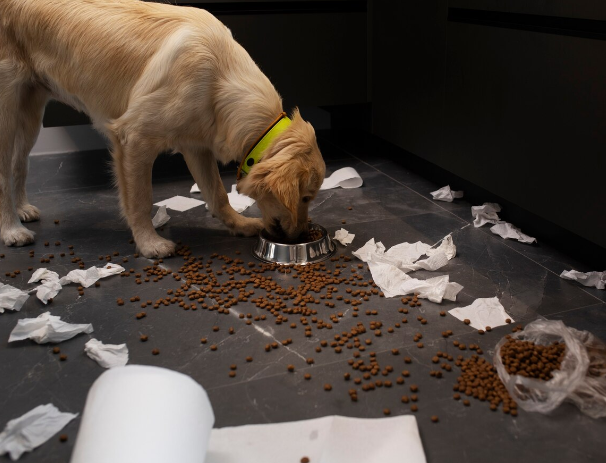
Looking for food leftovers in the trash bin or other possible sources of food is a common type of behavior in dogs when they are hungry.
You should keep in mind that, some canines are extremely food-driven, so constantly looking for food could become a behavioral issue that you need to address. This would be especially needed when outdoors, so you can ensure that your dog won’t eat something (non-edible too) which is potentially dangerous for them.
Some rescue dogs, who have lived a long time on the street, continue showing this type of behavior even after they find their forever home. It is essential that you have the right approach towards your dog, based on their experience and personality, and encourage them to show the wanted behavior.
Wandering from one area to another, whether at home or outdoors, looking for food, can be triggered by various factors, like the smell of preparing food, the sound of people opening bags of food like snacks, or the sight of other animals or people eating.
It is crucial for your dog’s health to put the trash bin in a place that they won’t be able to access it and also always supervise your paw friend when on walks. Do not let them eat items off the floor or ground as they may be toxic, fragile, or otherwise harmful to your beloved furry friend.
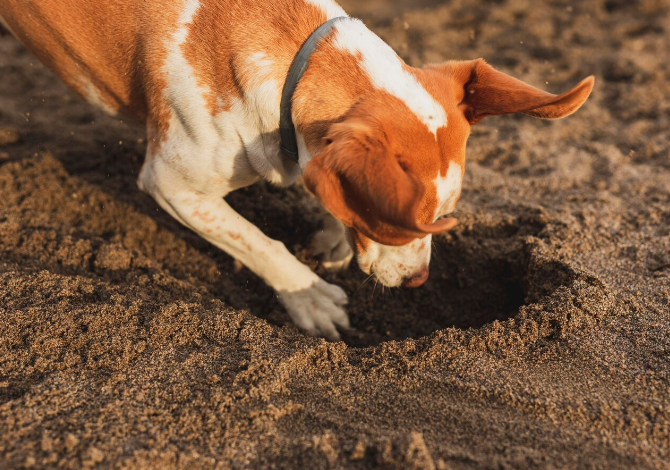
Digging the ground and scratching the area surrounding their food bowl can be perceived as a way for your dog to tell you they are hungry.
Where does this behavior come from? It can be tracked down to their ancestors, who used to bury their food in case of shortage and to protect it from competitors.
Another reason for that is communicating with other animals that this is their territory. Dogs’ paws have scent glands that give off their scent when scratching and digging as a type of marking.
Although some of the reasons for these types of behaviors are food-related, scratching and digging can be perceived as tools to alleviate stress and anxiety or even excitement about the meal they are expecting.
Last, but not least, dogs who lack physical and mental stimulation can develop many behavioral issues. Make sure to provide your canine with options to exercise and keep their mind sharp.
It is worth noting, that digging in the garden/backyard looking for food, can be related to a condition known as “pica”. It is characterized by the desire and the urge to eat non-edible items such as dirt, rocks, or clothing.
If you have even the slightest doubt that your paw friend may suffer from this condition, you should consult with a veterinarian. Also, you should find out any triggers in the environment that may cause distress in your canine and lead to compulsive behaviors like that.
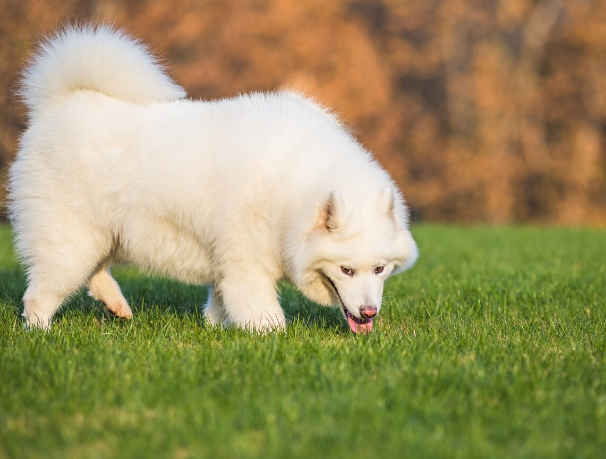
Eating grass is believed to be a behavior shown by dogs to soothe their upset stomachs or get more fiber in case their diet is not nutritional and diverse enough.
According to a study conducted in 2007, there is a correlation between the intensity of eating grass and the level of satiety. Dogs are less likely to eat grass after mealtime and more likely to do it before that.
We would advise you to keep track of your dog’s food intake and the type of food they eat. Make sure, it is nutritional and adapted to their age, breed, activity level, and health.
A balanced diet that includes dry and wet food, as well as fresh dog-safe fruits and vegetables is always recommended. If you have time to cook for your furry friend, we encourage you to do so. Cooked rice, non-fatty fish, chicken, beef, eggs, and steamed vegetables may be good supplements to your dog’s regular food.
Make sure that they are well-prepared and given to your dog occasionally and not as a constant part of their diet.

Some dogs tend to become very attached to their human family members and love following them everywhere like a shadow.
If your canine starts nudging you, pawing you, or following you from room to room, then they may want to indicate that it is meal time.
They can even start barking at you, circling around you, jumping on you, or nudging their food bowl, if the “gentle” cues do not produce the desired outcome.
Alternatively, your paw friend may want to tell you that they need to go out for a walk/potty break or that they want to play with you. If you are too busy to spend quality time with your furry friend, they may feel neglected and seek your attention.
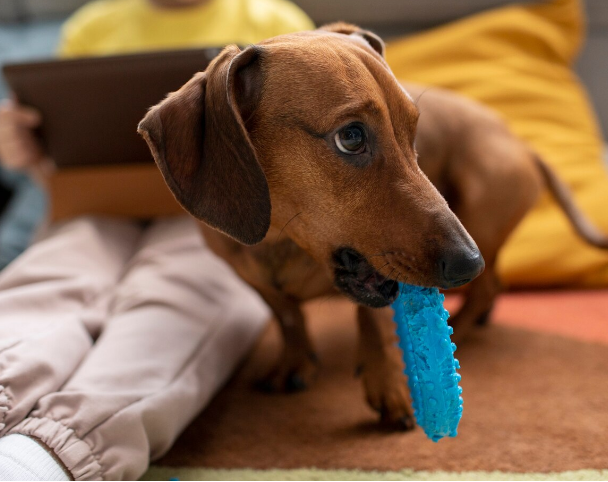
If your pooch abruptly starts chewing, biting, or directly trying to eat items, they are usually not interested in, this might be a sign that they are hungry.
Due to the larger number of olfactory receptors, dogs’ sense of smell can be up to 100,000 times more acute than ours. Therefore, our canine companions can detect smells from much greater distances than we can. As a natural response to the smell of products that cause drooling and salivation, your pooch may start looking for food and chewing on random items, if you have not fed them on time
Make sure that your dog does not miss meals and that they satisfy their nutritional needs. Avoid feeding your canine leftovers or junk food while you are eating. This can prevent them from eating their regular food, which is specifically designed to meet their needs, and can also cause them gastrointestinal issues in the long term.
Trying to eat items that they usually wouldn’t may be a way for your dog to communicate to you their need for affection, and attention. Don’t let your canine be bored throughout the day and ensure they are provided with interactive toys and options to stay engaged and happy.
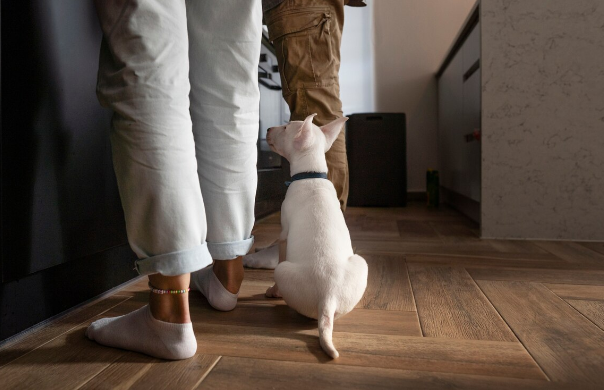
Improper or hunched posture can be a sign of being underweight or be interpreted as an indication by your dog that they are hungry. However, the body language of our paw friends expresses both their needs and emotions. Having a hunched posture could mean that your dog is in distress due to triggers in the surroundings like very loud noises, the presence of people or animals they perceive as a threat, or the absence of a beloved human causing separation anxiety.
It is important that you are able to identify the reason for the behaviors your dog exhibits.
If your canine’s improper posture has to do with a lack of nutrients or the need for a healthier diet or larger portions, then it is best to consult with a veterinarian on what diet would be suitable for them. They will give you advice on whether you need to entirely change your dog’s diet or maybe just add supplements for enrichment.
If the hunched posture is not related to a lack of food at all, then you should work on environment management. Make sure your dog’s living environment is safe, and comfortable to them and provides them with opportunities to stay mentally and physically fit. You should, of course, pay attention to the outdoor surroundings too, and ensure that they do not include any stressful factors.
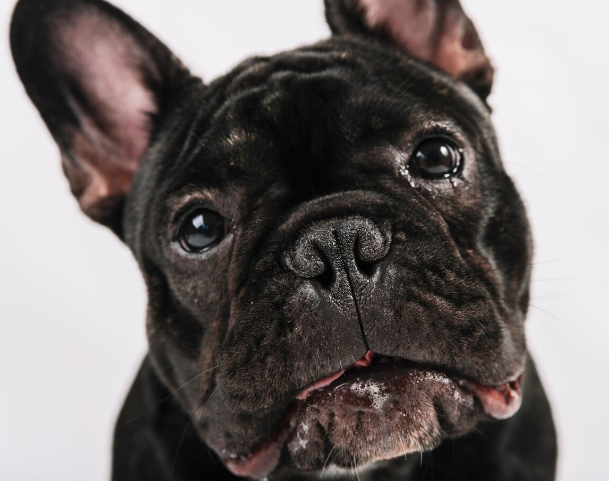
We all know how our pups tend to look at us when they want something- whether it is to be fed, taken out for a walk, or when they just want us to play with them. It is usually very hard to resist those big loving puppy eyes!
Although it is very difficult to tell “No” to your pup, you should think of their health first. Make sure to feed them properly. Both overfeeding and underfeeding should be avoided if you want your dog to be fit and healthy and enjoy your company for many years.